
About UsThe Numismatic Bibliomania Society is a non-profit organization promoting numismatic literature. For more information please see our web site at coinbooks.org SubscriptionsThose wishing to become new E-Sylum subscribers (or wishing to Unsubscribe) can go to the following web page link MembershipThere is a membership application available on the web site Membership Application To join, print the application and return it with your check to the address printed on the application. Membership is only $15 to addresses in the U.S., $20 for First Class mail, and $25 elsewhere. For those without web access, write to: David M. Sundman, Secretary/TreasurerNumismatic Bibliomania
Society AsylumFor Asylum mailing address changes and other membership questions, contact David at this email address: dsundman@LittletonCoin.com SubmissionsTo submit items for publication in The E-Sylum, just Reply to this message, or write to the Editor at this address: whomren@coinlibrary.com
BUY THE BOOK BEFORE THE COINYou won't regret it! |
- WAYNE'S WORDS: THE E-SYLUM JULY 3, 2011
- NEW BOOK: COLLECTING RARE COINS FOR PLEASURE AND PROFIT BY DAVE BOWERS
- NEW BOOK: COINS, GLASS STAMPS AND WEIGHTS AT ISTANBUL UNIVERSITY
- 2011 SUMMER ANA CALL FOR EXHIBITS
- A PLEA FOR A GRADUATE RESEARCH ASSISTANT
- ARTICLE PROFILES COIN AND MEDAL DESIGNER JAMIE FRANKI
- 1933 DOUBLE EAGLE LITIGATION CONTINUES JULY 7, 2011
- 1787 CONNECTICUT CENT REDBOOK PLATE COIN HISTORY
- THE CONSTELLATION SOUVENIR MEDAL
- NOTES FROM E-SYLUM READERS: JULY 3, 2011
- NATIONAL PUBLIC RADIO HIGHLIGHT'S AMERICA'S DOLLAR COIN PROBLEM
- JOHN MERCANTI BECOMES SPOKESMAN FOR GOLDLINE
- QUEEN UNVEILS DIAMOND JUBILEE MEDAL FOR PUBLIC SERVANTS
- QUERY: CLEANING COINS USING LASERS
- ARTICLE HIGHLIGHTS "ILLEGAL" GERMAN COIN FOUND IN NORWAY
- THE MEDALS OF SIGISMONDO MALATESTA
- THE WEIRD WAYS OF READERS AND BIBLIOPHILES
- NEW CHARGES FORTHCOMING IN THE SECURENCY BANKNOTE PRINTING BRIBERY CASE
- NEW TECHNOLOGY DETECTS COUNTERFEITS
- CARVED BOOK ART
- LOST-AND-FOUND TALE OF 40 SILVER DOLLARS
- FEATURED WEB PAGE: CONGRESSIONAL GOLD MEDALS, 1776-2010
WAYNE'S WORDS: THE E-SYLUM JULY 3, 2011

Among our new subscribers this week are Eric Schena, Tom Michael and Charles B Smith Jr. Welcome aboard! We have 1,432 email subscribers, plus 149 followers on Facebook, including Tumpal M R Full.
This week we open with some great news from Bob Lyall, who writes:
 Paul Dawson, director of Spinks, has made an amazing recovery from his serious accident on the motorway and has now been moved to a hospital nearer to his parents - it was only 21 days earlier that the hospital was considering switching off his life support machine! What brilliant news.
Paul Dawson, director of Spinks, has made an amazing recovery from his serious accident on the motorway and has now been moved to a hospital nearer to his parents - it was only 21 days earlier that the hospital was considering switching off his life support machine! What brilliant news.
We wish Paul and his family the best as he continues his recovery.
Next up in this issue are announcements of two new numismatic books. Other topics include an update on the 1933 Double Eagle litigation, the 1787 Connecticut Cent Redbook plate coins, and new technologies for combating counterfeiting.
To learn more about Ferritic stainless steel coins, cleaning coins with lasers, The Mint's billion-dollar coin pileup, John Mercanti's new gig, Jamie Franki's parade, and how to literally sniff out counterfeits, read on. Have a great week, everyone!
Wayne Homren
Numismatic Bibliomania Society
NEW BOOK: COLLECTING RARE COINS FOR PLEASURE AND PROFIT BY DAVE BOWERS
 Whitman Publishing has released a new book, Collecting Rare Coins for Pleasure and Profit: An Insider's Guide to Today's Market, by Q. David Bowers. The 144-page book is available online (including at WhitmanBooks.com), and from booksellers and hobby shops nationwide, for $9.95.
Whitman Publishing has released a new book, Collecting Rare Coins for Pleasure and Profit: An Insider's Guide to Today's Market, by Q. David Bowers. The 144-page book is available online (including at WhitmanBooks.com), and from booksellers and hobby shops nationwide, for $9.95.
"There is no substitute for knowledge when you buy coins," writes coin dealer and award-winning author Q. David Bowers. In Collecting Rare Coins for Pleasure and Profit, he shares 50-plus years of insight on the rare-coin hobby and market.
The book is intended for those seeking to intelligently build a fine coin collection. Bowers notes that "Many people these days walk into coin shops wanting to buy silver and gold coins, or ‘coins that may be a good investment.' Most desire to get more information, but not to become rocket scientists in numismatics or devote many hours to deep study. This book serves that curiosity and that need for advice. It is oriented more toward the serious buyer, as opposed to someone who might start by buying coin folders and looking for interesting coins in pocket change."
Bowers is the author of more than 50 books, many of them best-sellers. "Dave has an engaging style that's like sitting down with a longtime friend and talking about coins, history, finance, art, and more," said Whitman publisher Dennis Tucker. "He makes learning enjoyable, as he illustrates his concepts with real-world stories and examples."
Collecting Rare Coins for Pleasure and Profit starts with an overview of American coin collecting and investing from the 1700s to today. "The past is very interesting," Bowers writes, "and you will benefit from learning about price trends and market cycles." Then he discusses how to be a smart buyer of rare coins. In 10 chapters, he gives useful insight on how to maximize return while enjoying everything numismatics has to offer.
# # #
Collecting Rare Coins for Pleasure and Profit: An Insider's Guide to Today's Market
By Q. David Bowers; foreword by Kenneth Bressett
ISBN 978-079483406-7
144 pages, softcover, full color, 6 x 9 inches
Retail $9.95
Contents: Foreword by Kenneth Bressett • Welcome to Coin Collecting! • Early Popularity of Rare Coins • The 20th-Century Coin Market • The Coin Market Becomes Dynamic • Grade and Its Effect on Price • Numerical Grading, 1 to 70 • How to Be a Smart Buyer • Starting a Fine Collection • Great Collectors and Collections of the Past (by Jeff Garrett and Ron Guth) • Questions and Answers • Afterword and Notes • Recommended Reading • Credits and About the Author
NEW BOOK: COINS, GLASS STAMPS AND WEIGHTS AT ISTANBUL UNIVERSITY
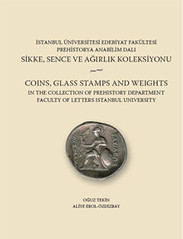 Coins, Glass Stamps and Weights in the Collection of Prehistory Department Faculty of Letters Istanbul University / Istanbul Universitesi Edebiyat Fakultesi Prehistorya Anabilim Dali Sikke, Sence ve Agirlik Koleksiyonu
Coins, Glass Stamps and Weights in the Collection of Prehistory Department Faculty of Letters Istanbul University / Istanbul Universitesi Edebiyat Fakultesi Prehistorya Anabilim Dali Sikke, Sence ve Agirlik Koleksiyonu
Author: Tekin, Oguz - Erol Ozdizbay, Aliye
Publisher: Ege Yayinlari
ISBN: 9786055607609
Publication Date & Place: 2011, Ýstanbul
Dimensions: 165x235mm, 1100 gr.
This book presents a catalogue of coins as well as some glass stamps (sences) and weights in the collection of Prehistory Department of Istanbul University. In the catalogue there are totally one hundred sixty five pieces and among of them are one hundred fifty six coins, six glass stamps, two weights and one indistinct discoid bronze object, all found during the surveys and excursions carried out in Anatolia by the academicians from the Prehistory Department and neighbouring disciplines between 1940s and 1980s.
For more information, see:
Coins, Glass Stamps and Weights in the Collection of Prehistory Department Faculty of Letters Istanbul University
(www.zerobooksonline.com/eng/product_details.asp
?cat=&subcat=&product=5941)
DON'T BE LEFT OUT OF THE CONVERSATION!
2011 SUMMER ANA CALL FOR EXHIBITS
Although exhibit setup at the ANA's 2011 Anniversary convention is still six weeks away, completed exhibit applications must be received at ANA headquarters by July 20. If you were working on an exhibit, please do not miss this deadline. There were no exhibits of Numismatic Literature the last few conventions, but maybe we can see some this year. Send any questions to the local exhibits committee at ANA2011Exhibits@ChicagoCoinClub.org
Suggestions on forming an exhibit can be found on the main ANA exhibiting page at
http://www.money.org/Content/NavigationMenu/NumismaticEvents
/ConventionExhibits/default.htm
and the
http://www.worldsfairofmoney.com/index.php?id=255
page has links to everything for exhibitors: rules, application, and more.
Remember, the exhibits must be in place by the early Tuesday morning opening of the convention, and the exhibits cannot be removed until very late on Saturday afternoon (when the convention closes).
Collector exhibits will not be the only attraction during August 16-20, Tuesday through Saturday. The ANA web site has a schedule of events, including club meetings, featured speakers, and other activities. A link to the schedule is at http://www.worldsfairofmoney.com/index.php?id=52
A PLEA FOR A GRADUATE RESEARCH ASSISTANT
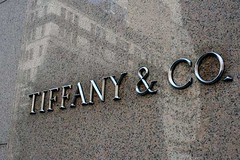 It has been six years since I last visited the archives of Tiffany & Co. -- reported here in The E-Sylum November 13, 2005 (vol 4, no 48 art 7). I had invited numismatic author and top researcher Katie Jaeger to join me for that research excursion. She proved quite useful in asking questions I wouldn't think to ask of our archive hosts (two heads are better than one). We examined a scrapbook and a journal, both with the title "Medals" on the spine as our major interest and obtained photocopies of the index to these two volumes.
It has been six years since I last visited the archives of Tiffany & Co. -- reported here in The E-Sylum November 13, 2005 (vol 4, no 48 art 7). I had invited numismatic author and top researcher Katie Jaeger to join me for that research excursion. She proved quite useful in asking questions I wouldn't think to ask of our archive hosts (two heads are better than one). We examined a scrapbook and a journal, both with the title "Medals" on the spine as our major interest and obtained photocopies of the index to these two volumes.
This time I invited Florida collector Joe Kane, who has amassed the largest collection of Tiffany medals of which I am aware, to join me. We had planned to base a catalog of Tiffany medals on our two collections and add to it any we could learn about in the archives of Tiffany.
The policy for outside researchers has changed dramatically since I last visited Tiffany. Policy now is to limit access to only six outside researchers a year. We were extremely fortunate to be granted entry this year. Not only are credentials necessary, but also a letter from a publisher or similar stating the intent to publish. Perhaps my previous two visits had eased the way.
I had a dual purpose. I wanted data on every medal Tiffany had made. Plus, in my new capacity as Corporate Historian of Medallic Art Company, I wanted to see the correspondence between MACO and Tiffany. As medal manufacturer, MACO had served Tiffany in that capacity for the entire 20th century.
I particularly wanted data on the earliest such business connections, in 1905 and 1906, when MACO founder Henri Weil had reduced models by Augustus Saint-Gaudens of the 1905 Theodore Roosevelt Inaugural Medal, and the 1906 Benjamin Franklin Medal, plus the 1906 Henry Wadsworth Longfellow Medal by Bela Lyon Pratt-- all three of which were issued by Tiffany.
A cart filled with a dozen or more boxes awaited us as we arrived. "Start with these three boxes" our host suggested. We were served by the firm's chief archivist, who I had not met on my previous two visits. The three boxes were filled with medals. "You can photograph these if you wish" see also suggested.
A summer intern was assigned to assist us. My associate Joe pulled out his Blackberry and took a sample shot. It worked fine for an image, maybe not good enough for publication, but ideal for identification. Bless modern technology. My digital camera was left unused on the worktable.
As our intern unwrapped the medal from its plastic envelope, she retrieved the medal, and, often, a typed description of that medal. Someone with a good knowledge of medal terminology had described these at some time in the past. I examined each medal and passed on to Joe those that needed to be photographed. Then they were returned to their original envelope.
I rejected a few. "Why are these medals of European origin in with these Tiffany medals," I asked. The answer was they had been obtained by -- or for -- the Design Department and became "study objects" for Tiffany designers. They were placed in the archives for long term storage once a designer no longer needed them.
Joe took 310 shots, about 50 medals per box. We examined the remainder of the boxes on the cart with only one containing documents illustrating medals that were important enough to photograph.
As I finished up examining the contents of each box, Joe was invited into the archive vault. He was shown why our project was so daunting. There were 84 boxes marked "medals." He documented that by a couple of quick shots on his blackberry.
Later I stated to the archivist I wanted to come back for a two-week period to go through all those boxes. "Impossible!" stated the archivist. We had used up our one-time visit privilege. Also she would not photocopy the scrapbook or journal I had first viewed on my previous trips. Tiffany's policy is NOT to reproduce a complete book intact.
However, she did provide a solution, neither of us had expected. One. Create a template of the data you desire. Two. Create a file and enter all the data by use of that template of the medals and the information you already have. Include the images of the medals you already have.
Three. Then hire a graduate student in art history as a research assistant. They would allow that research assistant in one day a month to enter the data you desire -- including images of medals from any document or archive they may have -- into that file. You would have to write your catalog from that electronic file.
On the drive back home we realized this was, indeed, a very intelligent approach tor our project. We didn't have to do the research work, just finance it.
And what about the correspondence between Medallic Art and Tiffany I wanted to see? No files on Medallic Art. It is by client of the medal. And it's all in those 84 boxes!
To read the earlier E-Sylum article, see: TWO NUMISMATIC RESEARCHERS AT TIFFANY'S (www.coinbooks.org/esylum_v08n48a07.html)
ARTICLE PROFILES COIN AND MEDAL DESIGNER JAMIE FRANKI
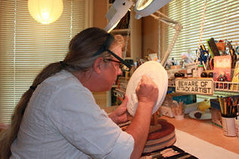 Jamie Franki, an associate art professor at UNC Charlotte, is riding a wave of popularity.
Jamie Franki, an associate art professor at UNC Charlotte, is riding a wave of popularity.
As a designer of coins and medals, he's seen his work reproduced by the millions, but he's also watched as pieces he painstakingly toiled over were cast aside, never making it past the initial clay form.
His latest test of popularity is playing out on Facebook and Twitter, as he vies with 167 other contestants, each hoping to have his or her design struck as the first-ever Winter Youth Olympic Games medal.
Franki, 49, has won plenty of times. His most well-known achievement came in 2005, when his design for the U.S. bison nickel triumphed over other national artists and was cast 936 million times by the U.S. Mint.
"For a while, the phone was really off the hook," said Franki, whose studio sits in a renovated mill house on McGill Street in Concord.
The city rolled out its best red carpet for the coin-making celebrity then. The mayor of Concord gave him an honorary key, and local organizers sought him out for the city's big parade.
"They put me in a '52 convertible red Bel Air, doing the Jackie O wave down Union Street," said Franki. "Some lady came up to me and said, 'Hey, are you supposed to be somebody?'"
He is well-known in the coin world. The bison design went on to earn a Coin of the Year award. "It's like the Oscars for coins," said Franki.
Bison nickels can be hard to locate now because collectors hoarded them shortly after they were made. The best bet may be to root around beneath a sofa cushion.
The flawed ones have become even more valuable. That is often the case, but it baffles an artist like Franki. "Can you imagine going to a car lot and saying, 'I'll take that Camry with the dent in it?'"
Six years have passed since the first bison nickel was struck, and Franki is ready to move on. "People used to refer to me as 'the nickel guy,' and while I appreciate that ... I still have plenty of brain cells and ticks on the clock."
His medal creations have become a success on their own. In 2008, the U.S. Olympic Committee selected his design for the Order of Ikkos medallion, a new medal created for winning athletes to present to the coach of their choice. The honor inducts the coach into the Order of Ikkos, named after Ikkos of Tarentum, the first Olympic coach in ancient Greece.
The heavy medals, made of nickel and silver, weigh just less than a pound, a noticeable weight when placed around the neck.
"I think it should weigh a lot," said Franki. "I think it should remind you that you did something that's lasting. Remember that, for that moment in time, you were amazing."
To read the complete article, see:
UNCC art professor is a heavy medal star
(www.charlotteobserver.com/2011/06/26/2401231/
uncc-art-professor-is-a-heavy.html)
1933 DOUBLE EAGLE LITIGATION CONTINUES JULY 7, 2011
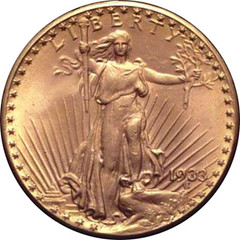 Another epic litigation is set to start July 7 as the U.S. government takes an old woman to court in Philadelphia. Of course the object is not typical, for the woman, Joan Langbord, and her sons are fighting to legalize and force the U.S. Mint to return to them 10 $20 gold coins dated 1933.
Another epic litigation is set to start July 7 as the U.S. government takes an old woman to court in Philadelphia. Of course the object is not typical, for the woman, Joan Langbord, and her sons are fighting to legalize and force the U.S. Mint to return to them 10 $20 gold coins dated 1933.
You would too if you once had coins in your possession worth $75.9 million.
The Langbord family places their trust in Barry Berke, a New York lawyer who worked miracles for British dealer Stephen Fenton when he was trapped in an FBI sting operation involving an identically described coin. It was eventually sold at public auction for $7.59 million and the profit was split between the U.S. Mint and Fenton.
Could a similar outcome occur again?
The Langbords probably hope so.
Joan Langbord is the daughter of Israel Switt, a Philadelphia jeweler and occasional coin dealer who evidently handled every 1933 double eagle that entered circulation, or at least left the Mint. Mrs. Langbord claims to have found the coins in a family safe deposit box.
She sent the coins to the Mint in 2004 to assure that they were authentic – they are– and then sat back while the Mint said she couldn't have them back.
To read the complete article, see: Langbord Case Back in Court (www.numismaster.com/ta/numis/Article.jsp?ad=article&ArticleId=21642)
1787 CONNECTICUT CENT REDBOOK PLATE COIN HISTORY
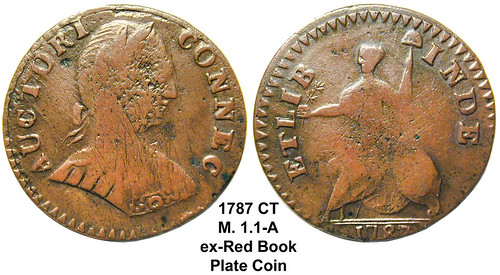
Jim Jones writes:
The subject Connecticut copper appears as a plate coin in the 1961 Red Book 14th edition, p. 29.
Red Book Editor Ken Bressett writes:
This coin was first illustrated in the 1961, 14th edition of the Red Book. It continued in use through the 1978, 31st edition.
David Stone writes:
I find this plate is in number 14, from 1961. A different example was pictured before that time. The picture was changed when the listing for the coin was moved from the bottom of page 28 to the top of page 29.
Frank Colletti (author of A Guide Book of the Official Red Book of United States Coins) writes:
I checked my run of Red Books, and the plate coin was first used in the 14th Edition, 1961, when the variety's listing was changed from: "1787 Cent, Small Head Facing Right" on the bottom of page #28 to the then current "1787 Cent, Small Head Facing Right ETLIB INDE" and "1787 Cent, Mailed Bust Facing Right, IND ET LIB" listings on page 29.
The old picture was used from the 1st edition (both printings) and was changed in the 14th with the expansion of the types as listed.
Strangely, the original plate coin was in better condition and was the same type of variety. The original had more detail was did not have any of the pitting as shown in the illustrated piece, and was better struck on the reverse.
There may have been a 'political' reason for the change, but we may never know why it was changed to a poorer condition piece.
Byron Weston adds:
Please pass along my appreciation to those who have responded!
To read the earlier E-Sylum article, see: QUERY: 1787 CONNECTICUT CENT REDBOOK PLATE COIN INFORMATION SOUGHT (www.coinbooks.org/esylum_v14n26a10.html)
THE BOOK BAZARRE
THE CONSTELLATION SOUVENIR MEDAL
Back in late June NBS Treasurer David Sundman forwarded the following note from a web site visitor:
My name is CDR Richard G. Graham, U.S. Navy Ret., and I reside in Concord, NH. From 1958 to 1962, I was assigned to the Navy Recruiting Station, Baltimore, MD and was a member of the original U.S. Frigate Constellation Restoration Committee. For many years the Station was instrumental in the raising of funds for the restoration of this ship.
Special Souvenir Medals, struck from copper spikes used in the original construction of the ship, were mailed to various Navy Commands throughout the world and the funds raised helped defer some of the costs of Constellation reconstruction, then ongoing in Baltimore.
I have many of the original medals, as well as the literature that was enclosed with each individually packaged medal. In addition to a short history and a description of the work being undertaken, the literature states: "This pamphlet was produced at no cost to the "Constellation" Committee by Bastian Bros. Co., Rochester, New York, manufacturer of the Medal. Artist: Edward L. Christie, Tower Building, Baltimore, Maryland".
In doing research on one of my fellow members of the Constellation Restoration Committee, I came across NBS commentary questioning the origin of the medal.
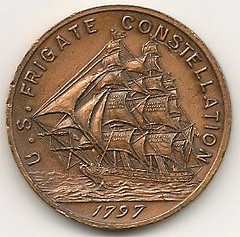
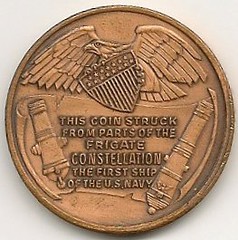
Obverse: Port bow view of the US Frigate 'Constellation' under sail. Legend: 'U.S. FRIGATE CONSTELLATION'. Exergue: '1797'.
Reverse: An eagle carrying the arms of the United States, below inscription between a carronade and a cannon. Inscription: 'THIS COIN STRUCK FROM PARTS OF THE FRIGATE CONSTELLATION THE FIRST SHIP OF THE U.S. NAVY'.
In an earlier article Max Speigel wrote:
As far as I know the USS Constellation medals made from copper from the ship entitled the possessor to free admission to the ship, which is now docked in Baltimore's Inner Harbor. I have heard that they will still let you enter for free if you show them one of the medals, but I have not tried it myself so I cannot say whether this is true.
The order form confirms this free admission offer.
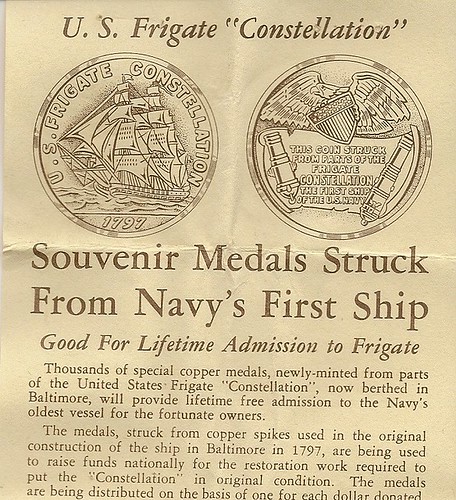
Dick Graham adds:
For your information, my son and his children, recently toured the Constellation in Baltimore Harbor, utilizing their Medals.
To read the earlier E-Sylum articles, see:
THE U. S. FRIGATE CONSTELLATION MEDALS (www.coinbooks.org/esylum_v12n36a22.html)
BILL FIVAZ AND THE U. S. FRIGATE CONSTELLATION MEDALS (www.coinbooks.org/esylum_v12n37a22.html)
MORE ON THE U.S. SHIP/FRIGATE CONSTITUTION (www.coinbooks.org/esylum_v12n38a20.html)
NOTES FROM E-SYLUM READERS: JULY 3, 2011
Using Contemporary Newspapers for Numismatic Research
This item actually came from the Yahoo Colonial Coins group, but it's very appropriate for The E-Sylum. Discussing the latest American Journal of Numismatics issue from the American Numismatic Society, David F. fanning writes:
ANS members are probably already aware of this, but there is an interesting article in the new AJN, "'Old Coppers Driven out of Office': Demonetizing Non-Federal Coppers," by Joseph Daragan. It concerns the efforts of the Federal government to restrict the passage of non-Federal coppers as money. It's a good example of using contemporary newspapers to conduct numismatic research.
My only quibble with the article is Daragan's citation of the Kleeberg article (Penny-Wise, March 2005, pages 44-48) on the so-called Strawberry Leaf cents as evidence of the counterfeiting of early U.S. large cents. The Kleeberg article has since been refuted and the Strawberry Leaf cents are accepted as U.S. Mint issues. But that's a minor point in this article.
Ray Williams added:
The article is interesting - I've wondered how long preFederal copper coins, foreign and counterfeit halfpennies circulated in the US. Now I know what the actual story is with respect to Government legislation, but how long were the old coppers accepted in circulation by the public? I know if I were offered a NJ Copper in change, I would NOT turn it away!
On Lovett's "Confederate Cents"
Bill Eckberg writes:
I hate to see conjecture presented as fact. To the best of my knowledge, nobody has ever found any evidence in any records of the Confederacy that Lovett was commissioned by it to strike coins for it. In the absence of evidence to the contrary, my view is that the "Confederate Cents" have to be considered fantasy pieces. Otherwise, I LOVED the piece on the Harper's "proposal."
To read the earlier E-Sylum article, see: HARPER'S WEEKLY "PROPOSAL" FOR A CONFEDERATE STATES COIN (www.coinbooks.org/esylum_v14n26a17.html)
Columbia As a Symbol for the United States
Arthur Shippee forwarded this item about Columbia. Nothing much numismatic, but it's a good general piece explaining some of the history of the image which appears on many numismatic items. Thanks. -Editor
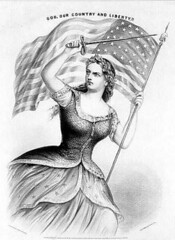 As Union soldiers went off to war, the national figure most often urging them on in political cartoons and political stump speeches wasn't Uncle Sam, but Columbia. Forgotten today even as her name adorns universities, rivers and cities across the country, Columbia was America's response to Britannia, a secular goddess who personified the national spirit. Both Britannia and Columbia were patterned after other goddess figures: Britannia copied Minerva's helmet, for example, and both symbols frequently identified themselves with the Goddess of Liberty by displaying or wearing the "liberty cap."
As Union soldiers went off to war, the national figure most often urging them on in political cartoons and political stump speeches wasn't Uncle Sam, but Columbia. Forgotten today even as her name adorns universities, rivers and cities across the country, Columbia was America's response to Britannia, a secular goddess who personified the national spirit. Both Britannia and Columbia were patterned after other goddess figures: Britannia copied Minerva's helmet, for example, and both symbols frequently identified themselves with the Goddess of Liberty by displaying or wearing the "liberty cap."
From these roots in classical symbolism, Columbia's identity gradually solidified during the first half of the 19th century. In these early days, Columbia, or her twin, the Goddess of Liberty, rivaled the American eagle in popularity as an emblem of public patriotic proclamation. While Columbia and Liberty remained more or less interchangeable, appearing on everything from weathervanes to tattoos, artists and writers intended Columbia to represent not just one virtue, liberty, but the entirety of American ideals.
To read the complete article, see: Hail, Columbia! (opinionator.blogs.nytimes.com/2011/07/02/hail-columbia/)
On Holed Slave Coins
Frank Colletti writes:
I don't know how I missed the previous week's article on 'Holed Slave Coins", but here is the explanation that I got from a metal detectorist about 20 years ago:
I had shown him a holed, low grade one reale coin that I had found while metal detecting. His reply, without hesitation was "nice, you found a slave 'token'".
Further information was related that the coins were normally very low grade Spanish coins, the coins were given to them (the slaves) by their owners. They were holed so that the slave could wear them tied on their right ankle. Supposedly, they believed that the silver coin would give them protection from diseases, and that the vein in the right ankle led directly to the heart.
I have never seen any other information about this anywhere else. However, I did hear it one more time from another old timer, also from Texas.

To read the earlier E-Sylum article, see: MORE ON HOLED SLAVE COINS (www.coinbooks.org/esylum_v14n26a07.html)
A New Steel Coin From India
Ultramodern numismatist P. K Saha writes:
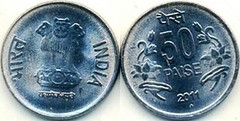 India has started a new definitive series with the first coin being launched. The coin is of 50 paise and made of steel. The dimensions are of erstwhile 25 paise which is no longer legal tender from 30th June. This new coin , therefore is proposed to be released only from 1st July.
India has started a new definitive series with the first coin being launched. The coin is of 50 paise and made of steel. The dimensions are of erstwhile 25 paise which is no longer legal tender from 30th June. This new coin , therefore is proposed to be released only from 1st July.
P.K. Saha adds:
This is new Ferritic stainless steel, which has been used for lower denomination coins in India since 1989 ( or so). The initial lot was 10 paise, 25 paise, 50 paise and 1 Rupee. 2 Rupees was done in 2004 and 5 Rupees for a short period when Nickel prices went too high ( between 2005 and 2007). It does not rust. However, some other mints tried the same composition but failed when their steel turned out to be magnetic.
Many other mints like Canada and Australia use Mild steel with Copper or Nickel plating for low cost coins. These tend to become rusted after their plating wears out and steel is exposed. I have seen it in coins of Nigeria and some other African and Asian countries.
Treasure found in Indian temple
Alan Luedeking writes:
I saw this story on the BBC News website.
Treasure, thought to be worth billions of rupees, has been unearthed from secret underground chambers in a temple in the southern Indian state of Kerala.
Precious stones, gold and silver are among valuables found at Sree Padmanabhaswamy temple.
The riches are thought to have been languishing in the temple vaults for more than a century, interred by the Maharajahs of Travancore over time.
They have not been officially valued and inspectors are taking an inventory.
Inspectors say they will continue cataloguing the treasure for at least one more week.
Unofficial estimates say that the treasure discovered so far over four days of inspections may be valued at more than 25 billion rupees ($500m). But historians say that assessing the true value of these objects is likely to be extremely difficult.
To read the complete article, see: India: Treasure unearthed in Kerala temple (www.bbc.co.uk/news/world-south-asia-13994351)
A huge treasure has been found in a Hindu temple in southern India — gold and silver jewelry, coins and precious stones worth billions of dollars, Indian officials said Saturday.
To read the complete article, see: Treasure worth billions reported in Hindu temple (www.msnbc.msn.com/id/43621678/ns/world_news-south_and_central_asia/)
NATIONAL PUBLIC RADIO HIGHLIGHT'S AMERICA'S DOLLAR COIN PROBLEM
Thanks also to readers Arthur Shippee, John and Nancy Wilson and others who pointed this one out. -Editor
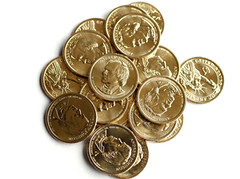 Politicians in Washington hardly let a few minutes go by without mentioning how broke the government is. So, it's a little surprising that they've created a stash of more than $1 billion that almost no one wants.
Politicians in Washington hardly let a few minutes go by without mentioning how broke the government is. So, it's a little surprising that they've created a stash of more than $1 billion that almost no one wants.
Unused dollar coins have been quietly piling up in Federal Reserve vaults in breathtaking numbers, thanks to a government program that has required their production since 2007.
And even though the neglected mountain of money recently grew past the $1 billion mark, the U.S. Mint will keep making more and more of the coins under a congressional mandate.
The pile of idle coins, which so far cost $300 million to manufacture, could double by the time the program ends in 2016, the Federal Reserve told Congress last year.
A joint inquiry by NPR's Planet Money and Investigations teams found that the coins are the wasteful byproducts of a third, failed congressional effort to get Americans to use one-dollar coins in everyday commerce.
If the mandate to make presidential coins wasn't enough to generate a growing heap of unwanted coins, a political deal ensured that even more unwanted coins would be produced.
It was easier for the bill's sponsor, then-Rep. Mike Castle (R-DE), to move the presidential coin bill forward if it didn't displace other dollar coins honoring Sacagawea, the teenage Native American guide to Lewis and Clark.
The deal: The mint would be required to make a quota of Sacagawea coins. Currently, the law says 20 percent of dollar coins made must have Sacagawea on them.
So, there are now about 1.2 billion dollar-coin "assets" chilling in Federal Reserve vaults, unloved and bearing no interest. By the time the presidential coin series finishes, and there are coins honoring all past presidents, there could be 2 billion.
Several congressional leaders contacted by NPR declined to comment for this story.
Both the Mint and the Federal Reserve provided information for this story, but neither agency would agree to an on-the-record interview.
Delaware's Castle, who left Congress after a primary loss and now practices law, acknowledges that the demand for golden dollars didn't materialize as he had hoped.
Castle says he and others knew when they were passing the bill that widespread adoption of dollar coins would be hindered by the continuing production of dollar bills. But he says that mandating a wholesale switch from bills to coins was politically untenable then, as it is now.
"It's not quite like cutting somebody's Social Security," Castle says, "but politically it's not something the members want to deal with, so it's just very hard to get something like that done."
When Congress was considering the law, the Congressional Budget Office warned that there would be low demand for the coins. The Federal Reserve Board cautioned that coin inventories and storage costs would increase.
Castle says the coins should continue to be produced, but in smaller numbers.
"It's ridiculous to have this kind of over-inventory pile up," he says. "I might actually make some phone calls myself as a result of reading these reports and learning more about what this problem appears to be."
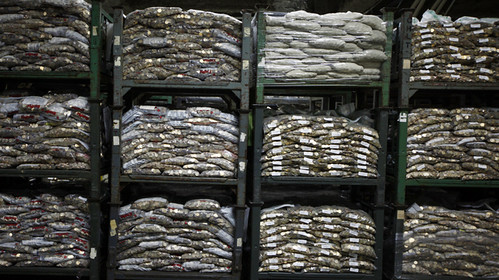
To read the complete article or listen to the radio story, see: $1 Billion That Nobody Wants (www.npr.org/2011/06/28/137394348/-1-billion-that-nobody-wants)
JOHN MERCANTI BECOMES SPOKESMAN FOR GOLDLINE
 Goldline International, Inc. today announced that John Mercanti, retired 12th Chief Engraver of the U.S. Mint, has become a paid spokesperson for Goldline. Mr. Mercanti will debut in a national television commercial for Goldline this week.
Goldline International, Inc. today announced that John Mercanti, retired 12th Chief Engraver of the U.S. Mint, has become a paid spokesperson for Goldline. Mr. Mercanti will debut in a national television commercial for Goldline this week.
"John Mercanti has made a tremendous contribution to our country and U.S. Mint history," said Scott Carter, Chief Executive Officer of Goldline. "It is an honor to have him as our spokesman."
John Mercanti served as the 12th Chief Engraver of the U.S. Mint before he retired earlier this year. During his 37-year tenure at the Mint, Mr. Mercanti sculpted over 100 coins and medal designs – more than any other engraver in U.S. Mint history.
"It was a distinct honor to be entrusted with creating America's most precious coins and medals," said Mr. Mercanti. "Now it is an honor to be associated with Goldline, a company that has been committed to serving precious metals investors and collectors for more than fifty years."
To read the complete press release, see: Goldline International Introduces Retired U.S. Mint Chief Engraver as Spokesperson (eon.businesswire.com/news/eon/20110628007006/en)
THE BOOK BAZARRE
QUEEN UNVEILS DIAMOND JUBILEE MEDAL FOR PUBLIC SERVANTS
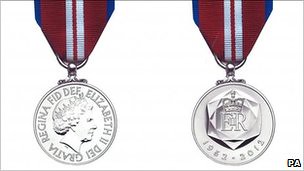
A medal to celebrate the Queen's Diamond Jubilee has been unveiled.
The official emblem is being launched to mark the monarch's 60 years on the throne. It resembles a 10p piece and bears the dates 1952-2012.
The armed forces, emergency services and prison service personnel are among those who will receive one.
Culture Secretary Jeremy Hunt said that, as the Queen had dedicated her life to public service, it was right to reward others who had done the same.
Living holders of the Victoria Cross and George Cross as well as members of the royal household will also be eligible for the award.
As are police community support officers who have completed five full calendar years of service.
The Diamond Jubilee celebrations will centre around a long weekend next year from 2 to 5 June.
Buckingham Palace will co-ordinate a programme of events on these dates including a Jubilee lunch, a pageant on the River Thames, a concert at the palace and the lighting of 2,012 beacons throughout the UK.
To read the complete article, see: Diamond Jubilee medal for public servants unveiled (www.bbc.co.uk/news/uk-13939458)
QUERY: CLEANING COINS USING LASERS
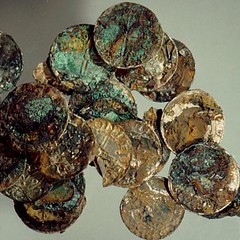 In April 2002 three metal-detectorists had the find of their lives in a field near Abergavenny, Monmouthshire: a scattered hoard of 199 silver pennies.
In April 2002 three metal-detectorists had the find of their lives in a field near Abergavenny, Monmouthshire: a scattered hoard of 199 silver pennies.
The hoard included coins of the Anglo-Saxon king Edward the Confessor (1042-66) and the Norman king William the Conqueror (1066-87). The hoard probably pre-dates the founding of Abergavenny near by in the 1080s.
The hoard was heavily encrusted with iron deposits, including traces of fabric, suggesting that the coins had originally been held in a cloth bag. It is not clear whether they had been deliberately hidden, or simply lost. Either way their owner was the poorer by a significant amount: sixteen shillings and seven pence (16s 7d, or £0.83p) would for most have represented several months' wages.
The Abergavenny hoard includes 36 identifiable mints, as well as some irregular issues which cannot at present be located. Coins from mints in the region, like Hereford (34 coins) and Bristol (24), are commonest, outweighing big mints such as London (19) and Winchester (20). At the other end of the scale there are single coins from small mints such as Bridport (Dorset), or distant ones such as Thetford (Norfolk) and Derby.
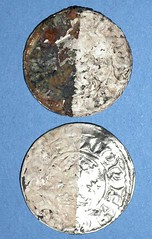 The coins were found covered in iron concretions and many of them were stuck to each other. This disfigured the coins and obscured vital details. Removing this concretion with mechanical methods, such as using a scalpel, would have damaged the silver, and chemicals failed to shift the iron.
The coins were found covered in iron concretions and many of them were stuck to each other. This disfigured the coins and obscured vital details. Removing this concretion with mechanical methods, such as using a scalpel, would have damaged the silver, and chemicals failed to shift the iron.
The solution to the problem was found in an unexpected, but thoroughly modern tool - the laser. A laser is a source of light providing energy in the form of a very intense single wavelength, with a narrow beam which only spreads a few millimetres.
As laser radiation is of a single colour (infrared light was used in this case) the beam will interact intensely with some materials, but hardly at all with others. This infrared source was absorbed better by the darker overlying iron corrosion than by the light silver metal.
The laser was successful at removing much of the iron crust, but initially left a very thin oxide film on the surface. When this was removed, the detail revealed on the underlying coin was excellent; it was possible to see rough out and polishing marks transferred to the coin from the original die, as well as the inscribed legend.
Bruce asked:
Does anyone know if lasers have been used for this purpose in the U.S.?
To read the complete article, see: Coins from Edward the Confessor and William the Conqueror found in Monmouth field (www.museumwales.ac.uk/en/rhagor/article/1942/)
ARTICLE HIGHLIGHTS "ILLEGAL" GERMAN COIN FOUND IN NORWAY
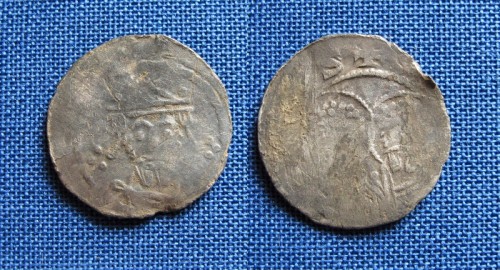
Archaeologists have found a 1,000-year-old coin minted under King Henry III on a royal farm in Avaldsnes.
University of Oslo archaeologists were looking for the farm rumoured to be on the island of Karmøy in Rogaland when they made their discovery.
The silver coin dates back to 1050. One side (left) has the face of King Henry, the Holy Roman Emperor (1046-56) wearing his crown. The other end (right) shows a glimpse of two saints, believed to be Simon and Judas with curly hair, beards and halos.
Professor Dagfinn Skre from the University brands the search as "the most exciting I have been involved in". "This German silver coin is extremely rare. In fact, foreign coins were illegal in Norway from the mid and to late 1000s. Only two similar archeological finds have been made previously," he told NRK.
Professor Skre is also manager for the Iron Age and Viking collections at the university's Museum of Cultural History, and has shown great enthusiasm for the coins, which weigh 0.84 grams and are 1.7 centimetres in diameter, according to the broadcaster.
This coin, found by a member of Rygene Detektorklubb, is believed to be part of a foreign currency exchange, transacted when King Harald Hårdrade and his son Olav Kyrre, later known as King Olav III, established a Royal mint.
To read the complete article, see: Rare ‘illegal' German coin found in Norway (theforeigner.no/pages/news/rare-illegal-german-coin-found-in-norway/)
THE MEDALS OF SIGISMONDO MALATESTA
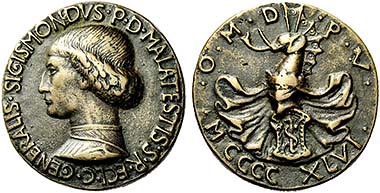
After all, the Renaissance had completely changed the relationship between the ruler and the arts. Painters, architects and sculptors were now assumed to be the ones telling future generations about the individual's fame for centuries to come. The adequate medium had just been invented: the medal, an object of the minor arts, showing on one side the portrait of the person celebrated, on the other a motif that could provide a more detailed characterization of the one depicted. The production of a medal was inexpensive, at least much more inexpensive then the hitherto common pictures. The medal was easily repeatable and hence met the rulers' demand. They had a new means of propaganda which was able to publicize their portrait and their achievements quickly and relatively cheaply.
The Malatesta family already was in close personal contact with the designer of the first Renaissance medal, Antonio di Puccio, called Pisanello. In 1433, he painted a portrait of the first wife of Sigismondo Malatesta. Approximately five years later, after the petition visit of the Byzantine emperor, John VIII Palaiologos, he had created the first medal. Shortly thereafter, most probably between 1444 and 1445, the medals by order of the Malatesta were produced.

The most famous medal for Sigismondo Malatesta was created by another great Renaissance artist, Matteo de'Pasti. In the meantime, when his wife had died, Sigismondo had married an illegitimate daughter of Francesco Sforza. At that time, he was at the height of his power. The year the medal's inscription states, 1446, was regarded by Sigismondo his lucky year: he won the Battle of Gradara, the Castel Sismondo, the fortress of Rimini, was completed, and he made beautiful, 13 year-old Isotta his mistress, daughter of a merchant from Rimini. No wonder, then, than a confident ruler of Rimini, wearing the armor of a military leader and a surcoat, proudly presents himself. Sigismondo Pandolfo Malatesta, captain-general of the Holy Roman Church – that was how this military commander called himself. The reverse likewise shows a motif indicative of war: an apparently invulnerable fortress, the Castel Sismondo in Rimini.
To read the complete article, see: Sigismondo Malatesta – Condottiere and Ruler of Rimini (www.coinsweekly.com/en/Article-of-the-week/5)
THE WEIRD WAYS OF READERS AND BIBLIOPHILES
Which brings to mind one of the major crotchets of my later years: An obsession with editions. I figure that if I'm going to spend any more of my too few remaining years in reading, I want the most enjoyable experience possible. So I eschew paperbacks almost entirely (except for the proofs that I often have to read when I'm reviewing), and, before I buy, I look hard at the physical design of the book, the quality of the type and the paper, the entire feel of the volume as it opens in my hand.
For the most part, I particularly gravitate to books published between roughly 1890 and 1940. They feel like real books. They've got heft, substance, especially those published by certain British companies.. Today's hardbacks--both British and American-- feel shoddy and gimcrack by comparsion: The bindings are cheap cardboard, the paper often this lifeless droopy stuff. The books all look terrible without their dustjackets and gaudy with them. By contrast, those older books were solid, meant to last, real books.
As for reading on screens--don't get me started. Can you really read anything serious and read it seriously if it comes on a screen? Screens are, by their nature, ephemeral, transient, insubstantial. Permanence is alien to their essence. One can, I suppose, whip through airplane novels and beach books on handheld devices , but why would you not rather have handsome editions of the classics and the books that mean something to you?
Oh, the weird ways of readers and bibliophiles!
To read the complete article, see:
Editions and Reading Formats
(www.washingtonpost.com/conversations/editions-and-reading-formats
/2011/06/24/AG3UAIjH_discussion.html)
NEW CHARGES FORTHCOMING IN THE SECURENCY BANKNOTE PRINTING BRIBERY CASE
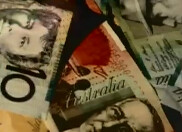 AUSTRALIA'S first foreign bribery prosecution will accuse two Reserve Bank currency firms and six of their former senior managers of funnelling multi-million-dollar bribes to high-ranking government officials in Indonesia, Malaysia and Vietnam to win bank-note deals.
AUSTRALIA'S first foreign bribery prosecution will accuse two Reserve Bank currency firms and six of their former senior managers of funnelling multi-million-dollar bribes to high-ranking government officials in Indonesia, Malaysia and Vietnam to win bank-note deals.
Police in Australia, Asia and Europe expect to lay further criminal charges and expose corrupt foreign politicians after yesterday charging with bribery Securency and Note Printing Australia, plastic-banknote design and printing firms that are respectively half and fully owned and overseen by the Reserve.
An international corruption taskforce led by the federal police is still working to uncover up to $25 million more in suspected bribes paid by the Reserve firms in Asia and Africa since 1999 and as recently as 18 months ago. The federal police inquiry began after a report in the Herald in May 2009 revealed Securency's multimillion-dollar payments to shady middlemen.
To read the complete article, see:
Bank bribes: more arrests imminent
(www.smh.com.au/national/bank-bribes-more-
arrests-imminent-20110701-1gv6q.html)
NEW TECHNOLOGY DETECTS COUNTERFEITS
A much bigger issue still exists; "Supernotes." Those are counterfeit bills that are hard to detect. They are made using the same type of government printer, exerting 30 tons of pressure on real currency paper.
"It gives it a 3D feel," Carnegie Mellon researcher Pat Sweeney said as he showed us the latest technology that he's working on to help detect the fakes.
We traveled to Carnegie Mellon's CyLab in Pittsburgh, which is working on new technology to help the Secret Service crack down on the problem.
"You might pass most of the 80 percent features but you might fail the last 20, and we want to catch the last 20," said Yang Cai, the lead researcher on the project.
Cai and his team have developed technology and software to scan the money quickly to enter it into a data bank so that Secret Service investigators across the country can quickly track counterfeit bills.
They're also developing imaging software that can scan the surface structure of a bill to determine its authenticity, as well as color fading technology using a pinpoint laser to determine if the ink is government issue or not. If that doesn't do the trick, they're also working on a "money sniffer."
"Ink normally uses a solvent and solvent contains a volatile organic compound, and these chemicals have a way to emit those signatures," Cai said as the device was demonstrated to us.
The sniffer turns the information into a computer algorithm to determine whether or not the money is the real deal.
The project is receiving funding from the Secret Service and no wonder. When you consider there are more than $100 million worth of fake bills in circulation every year, fast paced technology that can detect what the eye cannot will help the Secret Service immensely. Eventually Cai and his team hope to have a portable electronic detection device for merchants and banks as well.
When can we expect this to roll out?
"About 2 years," Cai said optimistically.
To read the complete article, see: New technology detects counterfeits (www.11alive.com/CIA/196084/320/Tracking-the-Money)
CARVED BOOK ART
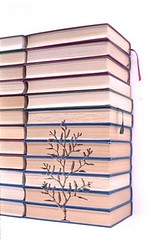 Kylie Stillman carves beautiful art out of thick books and tall piles of same. I love this effect -- it would be insanely awesome to typeset a series of books to accommodate this kind of cutting, and then sell them one at a time, requiring the whole set to realize the effect.
Kylie Stillman carves beautiful art out of thick books and tall piles of same. I love this effect -- it would be insanely awesome to typeset a series of books to accommodate this kind of cutting, and then sell them one at a time, requiring the whole set to realize the effect.
To read the complete article, see: Art carved out of books (www.boingboing.net/2011/06/30/art-carved-out-of-bo.html)
LOST-AND-FOUND TALE OF 40 SILVER DOLLARS
It lifts my spirits to think that it was 75 summers ago when Ed Baumgartner opened the doors to one of the big three of the Quad-City area supper clubs. His Saddle Club in Cordova, Ill., could keep pace with the other two, the Plantation in Moline and Marando's in Milan.
Details are unimportant. What has worried me is whatever happened to the 40 silver dollars that once were imbedded in the Saddle Club's front entry. Now, I am relieved.
The silver dollars — or at least the 37 that are left — have been saved. How they have been preserved is a sentimental story.
The silver dollar circle was a landmark. Customers would drop to their knees to touch the coins. It was said to be good luck if you held a finger to one of them and made a wish. Some diners courteously stepped around the silver dollars. Most just nonchalantly walked on them. But some nasty people kicked at the embedded dollars. Three were dislodged and pocketed through the years. Those silver dollars were trod upon by tens of thousands of people — notables like Ted Kennedy — because the Saddle Club was a top-drawer place.
When 1940 rolled around, Ed decided on a tribute to his success as a club owner and his big stable of palomino horses across from his club. Into the black terrazzo floor of the club's entry, Ed had craftsmen carve a 4-foot circle. Into this circle, an artisan molded an image of the head of a beige palomino horse, encased in brass.
Because it was 1940, Ed had 40 silver dollars imbedded in a circle around the horse head. He carefully watched so that every other silver dollar would be alternated heads and tails … one head, one tail; one head, one tail. Why heads and tails? The reason was never clear. Many of the dollars were 1940 issue. Others were much older. "One was from 1897," says Dawn Baumgartner, daughter of Ed.
Few things can forever last. The Baumgartner family closed the club and dance hall after the last cocktail was served on Dec. 19, 1976. The family, a sentimental bunch, left the old building standing until 11 years ago when it was razed. But what of the silver dollars? If they were built into the floor, would they not have plunged to the basement when the building was wrecked.
"Not so fast," says Dawn.
To read the complete article, see:
Lost-and-found tale of 40 silver dollars
(qctimes.com/news/opinion/editorial/columnists/bill-wundram
/article_d8de6bca-9f8b-11e0-9be6-001cc4c002e0.html)
FEATURED WEB PAGE: CONGRESSIONAL GOLD MEDALS, 1776-2010
This week's Featured Web Page is a report by Matthew Eric Glassman on Congressional Gold Medals, 1776-2010.The Continental Congress had not yet proclaimed its independence from Great Britain when, on March 25, 1776, George Washington, commander of the Continental Army, was tendered the first Congressional Gold Medal for his "wise and spirited conduct" in bringing about British evacuation of Boston. s During the next 12 years, the Continental Congress authorized an additional six gold medals for Revolutionary military and naval leaders.
In 1777, Major General Horatio Gates was recognized for his "brave and successful efforts" in bringing about the surrender of the British Army at Saratoga. Two years later, a similar honor was bestowed upon Major General Anthony Wayne in 1779 for his courageous assault on the British at Stony Point, NY.
A gold medal was also given to Major Henry Lee in commemoration of the skill and bravery he exhibited against the British at Paulus Hook, NJ. Brigadier General Daniel Morgan and Major General Nathaniel Greene were praised for their gallant efforts in South Carolina during 1781. Six years later, John Paul Jones was similarly honored for his "valor and brilliant services" in capturing the Serapis.
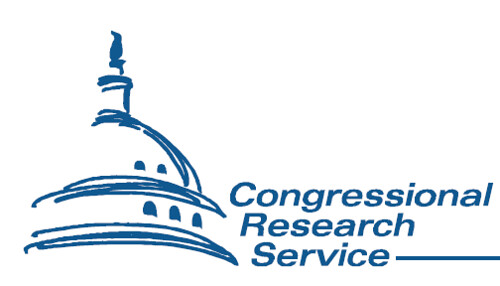
www.senate.gov/CRSReports/crs-publish.cfm?
pid='0E%2C*PL%5B%3C%230%20%20%0A
